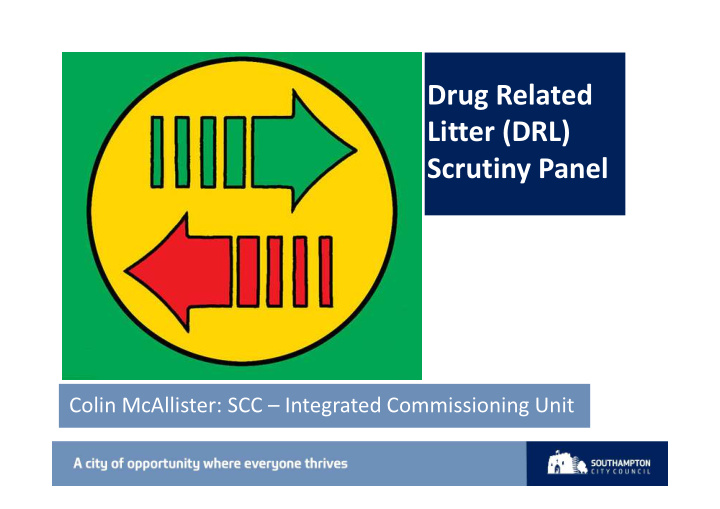



Drug Related Litter (DRL) Scrutiny Panel Colin McAllister: SCC – Integrated Commissioning Unit
Overview • Why provide Needle Exchange? • How we provide needle exchange. • prevalence of drug injecting in the city • trends • Drug Related Litter • The size of the problem • What we are doing about it • What else can we do about it?
Why provide Needle Exchange (NEx) What is NEX? A Harm Reduction Service • Providing Sterile Injecting Equipment • Needles, Syringes, Spoons, Swabs, Vit C, Citric Acid • Receiving and disposing of used equipment • Provide harm reducing advice and information • Injecting more safely, Overdose advice (and Naloxone), moving • from injecting to smoking drugs (foil) Other harm reduction equipment • Condoms • An entry point to treatment and support •
Evidence for Needle Exchange Lancet review 2011 (Specific focus on England) Direct benefits Reduces transmission of HIV • Reduces “risky” behaviours such as needle sharing • Indirect Benefits Increases retention of injecting drug users in services • Provides additional opportunity to engage users with other social • services http://ukpolicymatters.thelancet.com/policy-summary-needle-exchange- schemes-for-injecting-drug-users/
Life saving and cost effective NICE PH52 - National Cost (estimate) • £200 per person who injects heroin/crack cocaine per year, • £6 per person who injects image and performance enhancing drugs (IPED) per • year) Savings • £22,000-£41,000 saving per annum for every prevented case of hepatitis C • treatment £10,000-£42,000 saving (depending on disease progression) per annum for • every prevented case of HIV treatment As well as • Reductions in A&E attendances and associated bed days for injection site • infections Reductions in the need to treat blood-borne infections and viruses and any • chronic conditions arising from them.
UK Drug Strategy – July 2017 ………….Key to supporting improved health is action to prevent blood borne infections by vaccination (where available) and by maintaining the availability of injecting equipment through needle and syringe programmes…..
Background How many people use drugs in Southampton? Local National OCU 1483 (LCI 1105 – UCI 300783 1872) RATE per 1000 8.65 (LCI 6.45 – UCI 8.57 10.92) Unmet need 49% 50% How many people inject drugs in Southampton? NB Prevalence rates of people who inject amphetamines, New Psycho Active Substances and Performance and Image Enhancing Drugs (PIEDS) are less well researched From the evidence it would appear that DRL usually relates to people who inject illicit drugs such as heroin, crack and amphetamines rather than those who inject performing and image enhancing drugs. DRL finds in the community are often related to people with multiple vulnerabilities including those experiencing street homelessness and those inadequately accommodated and will include people travelling into Southampton, from other areas, to acquire and use drugs.
How is NEx Provided in Southampton Central NEx Hub within Community Substance Misuse Services • Key worker/ Care coordinator for those in treatment • 6 Pharmacies across the city • 2 Hostels for people who are experiencing homelessness • Police Custody • H-VAST • Street Pastors (carry sharps boxes) • SHPT? • Day Centre? •
How well do we do? Coverage • 636 estimated number of people who inject drugs • 775 unique NEx clients in 201617 • PIED & Amphetamine/ NPS users? • Approximately 360 per quarter • Equipment • Out • 2016/17 ‘Total Syringes’ = 198 379 • Returned • 2016/17 (estimate) = 103 686 (52%) • NB this does not include Pharmacy NEx returns or hostel returns • DRL ‘needles found’ • FromCommunitySafetyDrugLitterReports2016/17= 7065 ( 3.6% ) •
What are we doing to increase returns Most people who inject drugs return used equipment • It is the most chaotic and vulnerable people who are using drugs and • disposing equipment in the community What we do • Every person accessing NEx is given a sharps box (various sizes to • suit need) Discuss drug litter and safe disposal with every client • Photos of DRL are displayed to encourage conversations • People who do not return equipment regularly are challenged • H-VAST team are now offering ‘on street return opportunities • Discussions commenced with SHPT • Discussions commenced with Homeless Day Centre •
Thoughts from NEx “Colleagues and members of the public have commented on the • difficulty to report incidence of DRL” “Most of my clients are horrified about drug litter and do return used • equipment and/or dispose of it responsibly” “Reducing the provision of injecting and harm reduction equipment will • not reduce the injecting that takes place but it will increase the prevalence of BBV”
Police Police contact is normally via a member of the public contacting our control • room Control refer them on to the council contact numbers as per • https://www.askthe.police.uk/content/Q99.htm If officers are approached or find the litter they refer this to the council via the • control room. Only limited examples of this – unable to formally report as not, • currently, a reportable incident Police intend review this as a process with the council team. • Seeking a balance between our staff recovering items/ the risk this • presents - waiting for council attendance / leaving items in place that may cause a risk. Intend to formalise and communicate this instruction clearly for • officers working in the city.
Future • Southampton’s Drug Strategy • Day Centre • Improve information to the citizens of Southampton • Enhance cooperative work between services for people experiencing homelessness and community substance misuse services (H-VAST) • Scrutiny Inquiry Panel • A better understanding of the issues • Recommendations
Questions? colin.mcallister@southampton.gov.uk
Recommend
More recommend